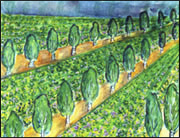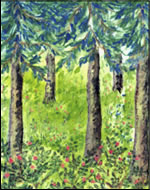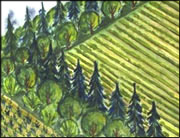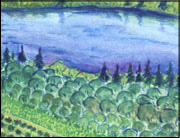Agroforestry
Agroforestry is a set of land management practices used around the world. They encompass the intentional integration of trees or shrubs with other crops or livestock. The five agroforestry systems commonly used in temperate agroforestry include: silvopasture, alley cropping, agricultural riparian buffers, forest farming/food forests, and shelterbelts/vegetative buffers.
There are regional variations reflecting temperate and tropical systems. Definitions in use in British Columbia follow North American conventions, the context of which is the integration of agronomic principles, practices and production with both forestry and conservation management approaches.
By leveraging the advantages of integration, agroforestry systems can yield a variety of benefits, including production gains, economic and social benefits, enhanced environmental function (e.g. conservation of soil, water, air and biodiversity) and climate change mitigation and adaptation benefits.
Operationally, implementation might involve design and establishment starting from a blank slate. However, it more commonly evolves from:
- Deliberately retaining or adding trees or shrubs into existing crop or livestock focused agricultural production systems; or
- Deliberately adding or enhancing crop or livestock management in forest production systems
Agroforestry farm practices
Basic factors of agroforestry systems
Intentional: Systems are planned, designed and managed for a combination of crops, livestock and trees while simultaneously providing environmental and social benefits.
Integrated: Systems are a blend of agriculture, forestry and conservation management practices and outcomes.
Interactive: Systems are designed to minimize negative and maximize positive interactions among trees, other crops, livestock and humans.
Intensive or extensive: Management will typically be more intensive than conventional management approaches as additional complexity is introduced with integration. However, management intensity will vary depending on the system design and desired outcomes.

Silvopasture in BC
Silvopasture blends trees, forages, and livestock managed as an integrated practice on the same land unit. These systems are purposefully managed for forage, livestock and forest products, or shrubs, fruit and nut trees. Silvopastures can be created by introducing or augmenting existing forages in treed systems or by introducing trees into pasture systems. In B.C., the use of silvopasture practices is typically supplementary to conventional forestry, range and pasture management. Silvopasture is not defined by grazing and forage production in the presence of trees and shrubs. Rather, all components (the livestock, forages and woody perennials) are combined through careful planning, implementation and management practices considering each of the elements and their potential interactions.
Examples might include grazing sheep or cattle among Christmas trees for competition management; beef cattle managed to graze fine fuels in the understory for wildfire risk reduction; adding forage, off stream water and retained shade to young forested grazing sites to attract livestock away from riparian zones; and, poultry use in orchards to reduce forage competition and consume insect pest and weed seeds.
Managing interactions
One way to view silvopasture is that it is about managing interactions. At a base level there are interactions between the trees and forage, forage and livestock, and livestock and trees. The interactions and effects on one another will shift over time with each having greater or lesser impacts on site resources depending on the stage of the silvopasture development.
Herbaceous Phase: Trees, shrubs and forages can all be directly impacted by livestock. Forages (seeded or native) may dominate the site with trees and shrubs competing for light, and soil resources.
Intermediate Phase: The tree and shrub canopies are at a stage where they no longer compete with the forage layer for light. Competition or facilitation for soil resources can be prominent. Livestock interact with and impact the forage layer, but their impacts on trees and shrubs is usually limited to physical impacts from rubbing or stepping on large surface roots.
Arboreal Phase: Mature trees and shrubs are of sufficient size that they control the availability of both above and below-ground resources. They exert a strong influence on the site by influencing temperatures, wind and heating. Livestock have limited to no impact on the tree and shrub layers, except for woody species that have a high concentration of surface or shallow roots which may be impacted by compaction or physical root damage.
Silvopasture resources
Factsheets, reports and video clips will continue to be uploaded to this site over the next months as material produced from collaborative pilots, demonstrations and other projects becomes available.
Silvopasture case studies – Producer perspectives
Silver Hills Ranch
Silver Hills Ranch is a commercial cow/calf operation nestled in the foothills of the Monashee Mountains, near Vernon, B.C. The ranch is known for the biodiversity of its land base with the southern aspect creating unique features with grasslands on the upper slopes, wet cedar-cottonwood stands along the river and three creek draws. The ranch manages five km of river corridor on its private land base.
While the scenery and landscape of the ranch is picturesque, it is limited to what it can be used for as far as growing something economically. Silvopasture fit the needs and site characteristics. The vision was a working forest taking advantage of opportunities to utilize the synergy of growing trees with grass to produce forage for beef and fiber for wood supply while supporting the ranch commitment to environmental stewardship – balancing beef and timber production with conserving biodiversity.
While the ranch has managed several areas as silvopastures over the years, where stands had been selectively logged and spaced, canopies were starting to close as trees started to reach maturity. A large windstorm in 2020 combined with drought and the subsequent arrival of several types of tree beetles, plus elevated wildfire risk necessitated management intervention. The ranch expanded their silvopasture approach, with the objectives of maintaining and enhancing forage values; maintaining, and enhancing ecosystem values; and, improving timber values.
Indian Gardens Ranch
Indian Gardens Ranch is located west of Kamloops, near Savona, B.C. The ranch is a cow/calf operation, relying on a mixture of tenures, including private land, grazing leases and Crown grazing licences. These areas span many different ecosystem types ranging from open grasslands at low-elevation to open-Douglas fir stands and up into higher elevation stands which consist of a variety of Douglas-fir, lodgepole pine and spruce.
The majority of the silvopasture work was conducted within grazing leases, at mid elevation on the ranch (~800 meters). These sites had seen a marked increase in timber density in the past half century due to not having been logged, fire deficit and ingress. Timber density was having a significant impact on the production of forage (grasses and forbs) and understory plant diversity and abundance.
Objectives of implementing silvopasture on the sites included creating forage values while supporting timber production; maintaining and enhancing ecosystem values; and, improving landscape resilience to wildfire.
- Case Study – Indian Gardens Ranch
Crystal Lake Ranch
Crystal Lake Ranch is a cow/calf and backgrounding ranch with approximately 200 mother cows. The ranch has forested land holdings and a woodlot which supports a small-scale wood products business. The ranch was founded in 1955 in Malakwa, B.C. The terrain in the area is comprised of rugged mountains and a narrow flat-bottomed valley. The vegetation is dense with little undergrowth. The limited agriculture land in the valley bottom gave rise to looking into the surrounding, more rugged terrain for summer grazing solutions. The ranch began grazing cattle on a Crown range tenure in the Yard Creek watershed in the 1970’s. At that time, much of the available forage came from silvopasture management approaches. The standard regime at the time was harvest, broadcast burn, seed grass aerially and plant tree seedlings. By 2005, changes in forest management had impacted forage supply.
Working collaboratively with the Ministry of Forests, Crystal Lake Ranch looked to silvopastures to manage both timber and forage together on the landscape, thus providing a sustainable forage supply without adversely impacting timber supply. Since 2015, Crystal Lake Ranch has established almost 340 ha of silvopastures within the Malakwa area and still grazes on the range licence that was once at risk of loss of grazing.
Objectives include creating forage values while supporting timber production; maintaining and enhancing ecosystem values; and, establishment of the new timber crop.
Coming soon: Silvopasture Case Study – Crystal Lake Ranch
Silvopasture in British Columbia information series
The series is a set of modules covering basic, intermediate and advanced topics. The infographic illustrates the major sections of information including:
- core units which outline the basics of silvopasture - what it is, why it might be and has been used, the science behind it, common management practices, and planning;
- case studies illustrating some of the concepts of the core units and highlighting producer experiences; and,
- supplemental units which support the core units by going into greater depth on some topics such as light and hydrology.
Each module introduces a new topic or provides real-world examples from BC and further detail which illustrate and reinforce the information covered in prior modules. Readers can follow along sequentially or hop around among the topics based on interest and experience. In essence the series is designed for on-demand self study. Alternatively, they may be used as the foundation for in-person or webinar workshop events as interest dictates.
Modules are designed as PowerPoint presentations and will gradually be added below over the next few weeks as both PDFs and narrated presentations (mp4).
| Core units | Case studies | Supplemental units |
|---|---|---|
| Series Overview: Slide deck (PDF, 1.1 MB) | Annotated deck (PDF, 1.1 MB) | Narrated presentation (Youtube) | ||
| Introduction | History of Silvopasture in B.C. | |
| Science Behind Silvopasture | Production Synergies: Kootenay Tree Farms
Riparian Silvopasture: Silver Hills Ranch
|
Light and Microclimate
Hydrology |
| Silvopasture Beneficial Management Practices – Part 1
Silvopasture Beneficial Management Practices – Part 2 |
Small-lot Silvopasture: Just Another Weed Patch Farm
Mature forest to Silvopasture: Indian Gardens Ranch |
Managing damage |
| Silvopasture Planning | Silvopasture Pilot Project – Collaborative Crown Land Example
Adaptive Management at Aveley Ranch |
|
Other agroforestry systems in B.C.
Combining agriculture, silviculture and conservation practices in the same land use system. Five main agroforestry systems are practical for use in British Columbia:

Alley cropping
Alley cropping is an agroforestry system broadly defined as the planting of single or multiple rows of trees and/or shrubs at wide spacings to create alleyways within which crops are cultivated. Both the crops and trees, or their products, can be harvested. Trees or shrubs are spaced to provide high light levels to the crops between them. This system suits crops that require more sun to mature and become marketable. An alley cropping example might consist of rows of trees for wood or other tree products (e.g. nuts or fruit), grown in conjunction with horticultural crops (e.g. vegetables) or field crops.

Forest farming / food forests
Forest farming is an agroforestry system broadly defined as the integrated management of both tree and understory crops; it focuses on managing a stand to benefit both the trees and the understory (plants growing under the tree canopy). It is the practice of intentionally managing site resources (e.g. light levels), and growth stages of the tree and understory plants for production, environmental and social values.

Shelterbelts / Vegetative buffers
Vegetative buffers are broadly defined as single to multi-row linear features of trees and/or shrubs. They may take the form of windbreaks, shelterbelts, hedgerows etc; and are designed to perform specific jobs. Site conditions and desired function affect the design and application, and help to determine the key features of the planting.
Tree and shrub plantings are designed to provide environmental goods and services, as well as economic, and social benefits. Benefits might include enhanced crop production (e.g. via shelterbelts for microclimate modification), reduced soil erosion (wind interception), protection of people and livestock (e.g. yardsite or livestock buffers for summer shade or reduced winter heat losses), lateral light interception (e.g. from greenhouses), dust and odour mitigation, interception of pesticide drift and water conservation

![]()
Programs are available to support the agriculture and agrifood industry:
Contact information
Agroforestry questions
Lisa Zabek
Agroforestry Specialist, Interior B.C.
250 312-7277
Lisa.Zabek@gov.bc.ca

